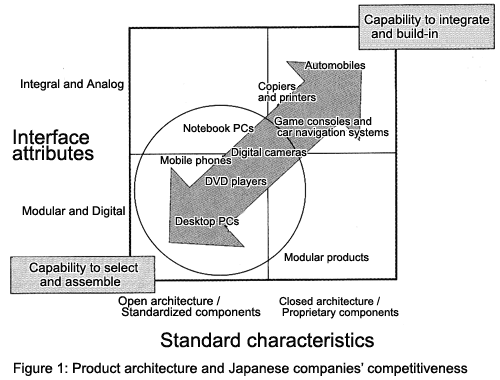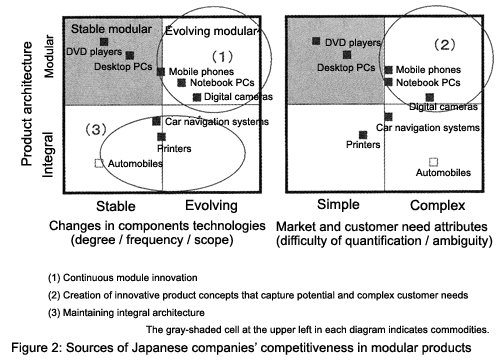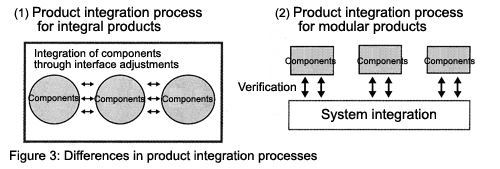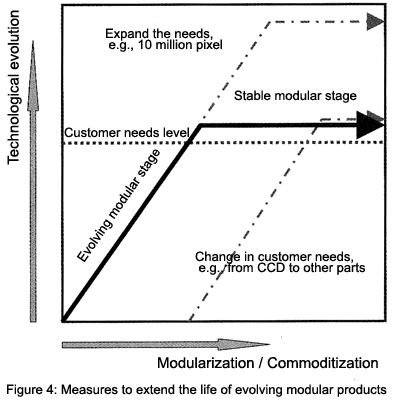Japanese companies have superior ability to produce products with integral architecture. Given the reality that more and more products with modular architecture are coming on the market, however, excelling only at integral products is insufficient. How can Japanese companies become competitive and profitable in the area of modular products? This study aims to answer that question.
Chinese companies have leaped to the top in the manufacture of DVD players and many other modular products. But when we look more closely, we find that there are some modular products in which Chinese companies are not competitive. What determines the degree of competitiveness in the manufacture of various products? While making reference to the case of China, I will examine this question to ponder how Japanese companies can improve their competitiveness in modular products.
Integral versus modular products
It has been said that the capability to simply assemble is required for modular products and the capability to integrate is needed for integral products. Japanese manufacturers, which generally excel at integration, are often seen as competitive in integral products but weaker in modular products.
Despite this perception, Japanese companies have come up with a wide range of ingenious modular products such as digital cameras, DVD player/recorders, notebook and mobile PCs, and camera cell phones. Discussing the so-called "Death Valley" problem of Japanese innovation would be important if it were the case that Japanese companies are unable to develop competitive new products, but the problem is rather that Japanese companies are failing to make profits despite introducing excellent new products to the market. Although the economy has finally begun to pick up, the long-term profitability trend for digital appliance makers is still heading downward. Even within a single home electronics maker, there are gaps in profitability among different divisions; those in charge of the latest hit products such as dishwashers and tilted-drum washer-dryers boast profit margins of 10% or more, whereas those operating in the digital camera, DVD recorder and flat-screen TV segments manage a profit margin of only a few percent at most. Thus, despite the fact that digital home appliances have been selling well, maufacturers'profits are thin. They are just like a farmer who generates only modest earnings despite having a bumper crop.
Figure 1 shows various products broadly classified as either modular or integral, based on their architectural attributes. Integral products are defined as having the following two characteristics: 1) integral and analog interfaces among different parts, and 2) Proprietary (i.e., non-standardized) parts and components. The most common example of an integral product is the automobile, whereas the desktop PC is a typical modular product.

In the case of automobiles, subtle and precise adjustments must be made for almost all interfaces between different parts and components in order to create a comfortable ride, drivability, maneuverability, and so on which are critical functional elements of any car. Also, in almost all cases, each automaker develops its own proprietary engines, an undertaking that can cost tens of billions of yen. This stands in stark contrast to how central processing units (CPUs) for PCs are developed; Intel develops most CPUs. The reason why automobiles remain an integral product is that cars are like a sophisticated work of art. It is not enough for a car to move from place to place for it to be accepted by consumers. They are willing to pay a premium for the meticulous work required to adjust and integrate a car's many non-standardized parts and components.
When a product remains integral, Japanese companies tend to remain competitive in its manufacture and they continue to enjoy high profits. In reality, however, most products eventually shift to modular type manufacturing. This is because modularization raises productivity and lowers costs-- something often sought by both companies and consumers. Thus, it is extremely important to think about how to enhance Japanese companies'competitiveness in modular products.
How to become competitive in modular products
There are three major reasons why Japanese companies are relatively weak in products with modular architectures. First, there is the problem of cost. When it comes to products that require simply procuring and assembling a vast number of standardized parts and components, Japanese companies cannot match their competitors in China, whose overhead costs are far lower than in Japan. The second problem concerns the creation of global networks. In this respect, Dell Inc. has established a very efficient system under which the company quickly procures the best components in the world, combines them into a finished product, and, if necessary, customizes the product according to the needs of specific customers. Japanese companies have thus far not managed to create such global sourcing networks. The third problem is "platform leadership," which is the ability to lead an entire industry in developing a product based on a global standard. Companies that develop and control the technology for the critical module, the core hardware or software, can achieve such leadership. Intel and Microsoft in PCs are two companies that have managed to do this. Japanese companies, although they have excellent technologies in certain parts and components, have so far been unable to become platform leaders.
I earlier compared the situation among digital appliance makers to that of a farmer making a modest living from a good harvest. This analogy fit first and best with makers of DVD players. Companies made tremendous profits on video tape recorders (VTRs) in the 1980s. But with DVD players, a modular product that appeared on the market in the 1990s, manufacturers were unable even to recover their development costs because prices fell so quickly and sharply. Driven partly by the need to cope with promoting standardization, Japanese companies pushed the development of mass production in China, providing Chinese manufacturers with product development and production skills, while selling them the more sophisticated parts and components they needed. This led to a sudden decline in the price of the end products. With modular products, unlike integral ones, manufacturers that lack certain key skills can still join the race. Such an environment tends to lead to excessive competition, making long-term profitability difficult no matter how innovative a company may be.
What then should Japanese companies do to become competitive in modular products and increase profits? One thing they can do is to pursue continuous innovation of modules. Actually, modular products have two completely different characteristics. Hence, there are two kinds of modular products: those with stable modular architectures and those with evolving modular architectures (Figure 2). One advantage of modular architecture is that many companies in the world, including venture businesses, can innovate independently and incorporate new technologies into their respective products-- parts, components and so forth-- as long as they follow the designated design rules. Once the wheels begin turning, it may lead to an explosion of innovation in the final product. Another distinctive feature of modular products is that a finished product can be produced simply by assembling parts and components that can be procured in the market. If this feature is utilized to reduce costs, technologies will immediately stop evolving and the product will become a stable commodity. When this happens, the business will no longer be profitable for Japanese companies.

I believe Japanese companies are and will continue to be competitive in evolving modular products. Surveys of Chinese companies show that they do not embark on full-scale operations on their own, but instead receive various instructions from Japanese companies. They are able to make huge profits by simply assembling parts and components purchased from Japanese suppliers. Probably because of this experience, there is a tendency among Chinese companies to wait until technologies stabilize.
Another possible way for Japan to maintain and improve its competitiveness is to keep developing the kind of products that offer an interesting and unique concept, or those for which design is critically important, by taking advantage of the low-cost feature of modular architecture: Modular architecture allows development of a number of product variations at a relatively low cost. For such products, functions are not the only thing that matters. The best example of this is the Apple iPod. Although it is a simple modular product, iPod has been able to fetch high prices because of its image and brand, rather than its functions.
The same trend is emerging in China at least to some extent for such products as digital cameras and mobile phones. In cases where market and customer needs are highly complex, consumers care a great deal about the design, brand, and ease of use of a product. With many products, it is impossible to retain integral architecture forever. This makes it all the more important to consider how Japanese companies can generate profits with modular products, for instance, by emulating the Apple iPod approach.
Japan's potential in products with evolving modular architectures
The types of products in which Chinese companies are competitive are those that compete on price to win consumers, such as desktop PCs and DVD players. On the other hand, Chinese companies are least competitive in such products as digital cameras and mobile PCs. These are evolving modular products in which individual modules are still subject to frequent technological innovation. With this kind of product, one cannot be competitive simply by assembling parts and components purchased from external suppliers.
At present, China manufactures roughly 70% of the world's DVD players. Indeed, 700-800 companies are manufacturing DVD players in China. The reason why there are so many producers is it does not require many special technological capabilities to assemble DVD players. Aware that they cannot build up their development capabilities as long as they remain content with mere assembly, some Chinese companies have begun to make efforts to improve their capabilities. Lenovo Group's buyout of IBM's PC unit is one such attempt. However, Chinese companies are also aware of their competitive advantage once technologies stabilize. Thus, the majority of Chinese companies have adopted a strategy of waiting for such stabilization. They have been lured into the trap of making easy profits from technologically stable, modular products.
It is misleading to simply compare modular products with integral products because modular products themselves vary greatly, depending on whether their architecture is still evolving or has stabilized. In the case of those with stable modular architecture, products of sufficiently high quality can be produced simply by assembling parts and components. Such modular products can be put together and mass-produced more easily than integral products. In the case of modular products with evolving modular architectures, however, product integration is as difficult as it is for integral products, and at times more so. This is why Chinese companies have been unable to enter certain modular product segments where parts and components keep changing.
I have just argued product integration is equally difficult for evolving modular products and integral products. But it is difficult in different ways. In the case of integral products, it takes painstaking efforts to make precise and minute adjustments among different parts and components during the process of their development, whereas modular products must be examined for interoperability after combining separately developed parts and components (Figure 3). Once the technologies for parts and components have stabilized, such examination becomes less necessary. But for products with evolving architectures -- in digital cameras, for example, in which innovation of module technologies has increased the number of pixels from 1 million to 2 million, to 3 million, it is extremely difficult to integrate modules into a finished product.

For modular products, both the frequency and degree of technological innovation are high because companies around the world compete simultaneously and independently to develop module technologies. Not only that, the scope of companies involved is wide because one does not have to be a large company to join the race. However, as frequency and degree of technological innovation as well as with the scope of participating companies rise, the difficulty of the integration task increases. In the case of modular products, the best combination of parts and components must be sought out. The greater the number of parts and components available for combination, the larger the task of checking the compatibility of each combination. Even before that, testing and verification must be carried out on each part and component individually. Then, of course, the end product must be tested for system integration.
In many of these verification tasks, Japanese companies are strong, particularly because they have technological capabilities in parts and components as well as in finished products. When people talk about modular products, they often think only about those with stable modular architectures. What is important for Japanese companies, however, is to strategically become competitive and utilize those technologies with evolving modular architectures.
But it is not easy to keep products in the "evolutionary" stage. I have cited digital cameras as an example of evolving modular products. But when the number of pixels reaches 5 million, we may have a situation where people say, "That's enough pixels." When this happens, technologies will stabilize and digital cameras will become a stable modular product, resulting in the commoditization of the product and giving Chinese companies an advantage in their manufacture. So what Japanese companies can do is to make sufficient profits before products reach that stage, and to delay the shift to stable modular architecture as long as possible (Figure 4). They can do this by developing and expanding the scope of existing consumer needs, for instance, by making buyers feel they need 10 million pixels in the case of digital cameras. Or they can try to change the nature of consumer needs through innovation in functions other than pixels. Japanese companies should draw up their strategies based on a clear recognition of the differences between the evolving stage and the stabilization stage.

Pitfalls of production networking and outsourcing of parts
Japanese companies seem plagued by a sense of resignation about modular products, which they feel are simply not profitable. Having defined the development of notebook PCs as low-value-added, companies such as NEC Corp. and Sony Corp. are outsourcing more the design and manufacture of their notebook PCs to Taiwanese original design manufacturers (ODMs), thereby providing them with considerable know-how and technologies. Meanwhile, Chinese companies are importing bare-bones, semi-finished computers from Taiwanese ODMs to develop their own notebook PCs. Japanese technologies are thus being siphoned off. If this situation is left unchecked there may come a time when Japanese companies are unable to earn profits even on evolving modular products.
In addition, Japanese companies are making more efforts on the sale of parts and components because individual modules (i.e., parts and components) within even a modular product have integral architectures and thus tend to be profitable. However, in order to sell such parts and components, Japanese companies need to provide various know-how and technologies to user companies, presumably Chinese manufacturers, so that they can properly assemble these parts and components into finished products. There is a risk that the more Japanese companies sell parts and components, the more the value added in the assembly process will decline. For some time, the sale of parts and components will remain profitable, but when prices of finished products begin to fall the added value of the parts and components will also shrink.
Two possible courses of action have been laid out for Japanese companies. One is trying to increase the lineup of integral products in which Japanese companies are competitive; the other is to be competitive in stable modular products, shifting to an American-style management centering on a horizontal division of work. However, rather than taking such an either/or approach, I would like to explore ways to enable Japanese companies to make use of their strengths in integral products so as to improve their competitiveness in modular products. Japan's past experience suggests that shifting to American-style management or strategy would not be a wise choice. I believe Japanese companies will be able to demonstrate their strengths in the area of evolving modular products. So I think the question that remains is how they can utilize these strengths in a way that increases customer value.
Question and answer session
Q: If evolving modular products are difficult to integrate, why can't Japanese companies keep their products at the integral stage?
A: When a completely new type of product is developed, it usually starts out as an integral product. Some remain that way, as has been the case with automobiles. But in most cases it is impossible to keep a product at the integral stage. Modularization offers substantial advantages such lower costs and enhanced productivity. Also from the viewpoint of serving customer needs, modularization makes it possible to offer a wide variety of product combinations at a low cost; and the standardization of interfaces, a key element of modularization, allows for greater compatibility. A product can remain in the integral stage only when, in the eyes of consumers, the value generated by meticulous integration of parts and components is greater than the merits of modularization. In the case of automobiles, consumers are willing to pay the cost of integration as they find great value in the overall performance, quality and design that can be provided only though meticulous integration of numerous parts and components. But this is not the case for most of other products.
Q: The upgrading of PCs seems to be implemented in a way of cleverly and periodically combining compatibility and incompatibility. Is this an example of a strategy to keep a modular product in the evolving stage?
A: Yes, that may be the case. With evolving modular products, whatever design rules you may set beforehand, you may have a situation where any combination just does not work once technological innovation comes into play on a certain part or component. This inevitably leads to further technological innovation or to the development of new design rules, which in turn becomes a driving force for the technological innovation for that particular modular product as a whole.
Q: Is the iPod an example of success in extending the life of an evolving modular product?
A: iPod is a stable modular product and the primary reason for its success is its effective utilization of design and brand power, which is another strategy for preventing commoditization, as shown in Figure 2. Some people cite the i-Tunes music downloading service as the number one reason for the success of iPod. But I would say that the superior design and ease of use counts even more than functionality or serviceability in making iPod so popular. Indeed, iPod is extremely popular in Japan even though legal music download service is not available yet here (as of early 2005). People know the importance of design but it is hardly ever discussed seriously by companies. The biggest reason for this is that people are unsure about how to assess design quality and how it relates to sales, and this creates great uncertainty as to what return the management can expect from its efforts to improve design.
Q: You said that technological innovation continues until a modular product becomes stable. Does this mean that Japanese companies have been able to innovate until now?
A: Taiwanese and American companies have been more competitive in PC parts and components than Japanese companies. This is partly associated with the degree of presence and activity of venture businesses, which play an especially important role in bringing about modular technology innovation. However, with respect to other products such as DVD players, digital cameras and flat-screen TVs, Japanese companies are strong not only in finished products but also in parts and components.
* The original Japanese text, published in the July 2005 edition of METI Journal, was compiled by RIETI editorial from a lecture delivered by Professor Kentaro Nobeoka at a seminar on April 21 and the Q&A session that followed.


